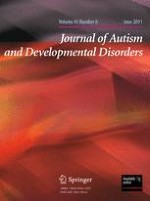01-06-2011 | Original Paper
Social and Non-Social Cueing of Visuospatial Attention in Autism and Typical Development
Gepubliceerd in: Journal of Autism and Developmental Disorders | Uitgave 6/2011
Log in om toegang te krijgenAbstract
Three experiments explored attention to eye gaze, which is incompletely understood in typical development and is hypothesized to be disrupted in autism. Experiment 1 (n = 26 typical adults) involved covert orienting to box, arrow, and gaze cues at two probabilities and cue-target times to test whether reorienting for gaze is endogenous, exogenous, or unique; experiment 2 (total n = 80: male and female children and adults) studied age and sex effects on gaze cueing. Gaze cueing appears endogenous and may strengthen in typical development. Experiment 3 tested exogenous, endogenous, and gaze-based orienting in 25 typical and 27 Autistic Spectrum Disorder (ASD) children. ASD children made more saccades, slowing their reaction times; however, exogenous and endogenous orienting, including gaze cueing, appear intact in ASD.
